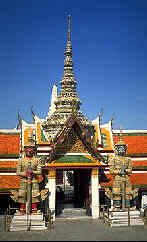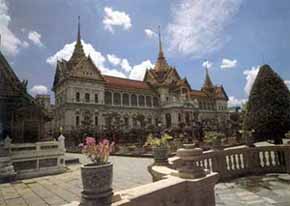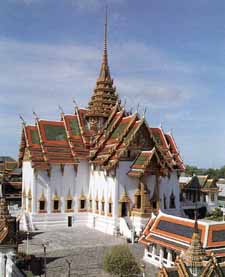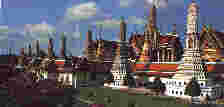

 This city landmark should be the first place on any visitor's itinerary. It is a huge
compound with entrance on Na Phra Lan Road near Sanam Luang, surrounded by high white walls.
This palace has an area of 218,400 square meters and is surrounded by walls built in 1782. The length of the four walls is 1,900
metres. The palace consists of several buildings with highly decorated architectural details. The Royal Chapel, Wat Phra
Kaeo, which is in the same compound, houses the Emerald Buddha, the most sacred Buddha image in Thailand.
This city landmark should be the first place on any visitor's itinerary. It is a huge
compound with entrance on Na Phra Lan Road near Sanam Luang, surrounded by high white walls.
This palace has an area of 218,400 square meters and is surrounded by walls built in 1782. The length of the four walls is 1,900
metres. The palace consists of several buildings with highly decorated architectural details. The Royal Chapel, Wat Phra
Kaeo, which is in the same compound, houses the Emerald Buddha, the most sacred Buddha image in Thailand.
When Siam restored law and order after the fall of Ayutthaya the monarch lived in Thonburi on the west side of the river. Rama I, on ascending the throne, moved the center of administration to this side of the Chao Phraya; and, after erecting public monuments such as fortifications and monasteries, built a palace to serve not only as his residence but also his offices--the various ministries, only one of which remains in the palace walls.
Grand Palace, which is the former royal residence (the Royal family now resides in the Chitralada Palace near the Dusit Zoo, this palace is not open for the public).
Building of the Grand or Royal Palace was begun after Bangkok was elevated to be the national capital (1782) . The first part
was completed for the coronation of King Rama I.
The plan of the palace followed the Ayutthaya
style - the river forms a moat on one side, the site of the temple of the Emerald
Buddha corresponds to the placement of Wat Phra Si Sanphet in the old royal palace at Ayutthaya. Many of the main buildings
also resemble those that where destroyed in Ayutthaya after the Burmese invasion.
The compound houses a number of halls, residences and other buildings which were built in the time of King Rama I (reigned 1782-1809). Some structures were altered, renovated, enlarged, or razed to make way for new buildings by later
monarchs. The palace compound can be sub-divided into four
complexes. Click here to view the map of Grand Palace.
The first building you reach is the Phra Maha Montien ("Great Residence") with the Amarinda Vinichai Throne Hall (which is the only part of the building that can be visited). The centerpiece of the Amarinda Vinichai Hall is a boat-shaped throne with gilded carvings and glass inlays, crowned by a nine-tiered white canopy. Also noteworthy are the decorative paintings on the walls and the ceiling.
Next comes the Chakri Maha Prasad ("Grand Palace")
- a renaissance style building, was built and resided in by King Chulalongkorn, Rama V (1868-1910). Only the reception portion is now used, consisting of two wings for reception purposes decorated
with galleries of portraiture. In between is the central throne-hall now used for various purposes and formerly for the reception of foreign
envoys on the occasions of the presentation of their credentials. It is aptly decorated with four canvasses of diplomatic receptions.
One on the right as one enters depicts the reception by Queen Victoria of King Mongkut's ambassador in London, further on
Louis XIV's reception of the mission sent by King Narai of Ayutthaya in the Galleries des Glaces in the Palace of Versailles; a
third, on the other side of the room, King Mongkut's reception of the French Envoy,
and the fourth of the reception at Fontainebleau by the Emperor Napoleon III of another Siamese Mission. The crystal decorations of
the hall are mostly presents from foreign monarchs to King Chulalongkorn. By the side of the inner grand staircase is the dining
hall attached to the building. This palaces houses elegant state rooms
and in the ground floor an exhibition of the royal weapons collection.
Chulalongkorn, Rama V (1868-1910). Only the reception portion is now used, consisting of two wings for reception purposes decorated
with galleries of portraiture. In between is the central throne-hall now used for various purposes and formerly for the reception of foreign
envoys on the occasions of the presentation of their credentials. It is aptly decorated with four canvasses of diplomatic receptions.
One on the right as one enters depicts the reception by Queen Victoria of King Mongkut's ambassador in London, further on
Louis XIV's reception of the mission sent by King Narai of Ayutthaya in the Galleries des Glaces in the Palace of Versailles; a
third, on the other side of the room, King Mongkut's reception of the French Envoy,
and the fourth of the reception at Fontainebleau by the Emperor Napoleon III of another Siamese Mission. The crystal decorations of
the hall are mostly presents from foreign monarchs to King Chulalongkorn. By the side of the inner grand staircase is the dining
hall attached to the building. This palaces houses elegant state rooms
and in the ground floor an exhibition of the royal weapons collection.
 The third important building is the
Dusit Maha Prasad ("Audience Hall") in which King Rama I was crowned
Audience hall has a throne of mother-of-pearl surmounted by the usual nine-tiered white
canopy, the mark of a duly crowned king. At the back of this audience hall is yet a living quarter. All are built in pure Siamese
architecture of perfect proportions. King Rama I built the Dusit Maha Prasat as a replacement for an earlier wooden Phra Thinang Amarintharapisek Maha Prasat
which burned down in 1790. King Rama I intended that the present building be used for his own Lying-in-State as it has the same
height and dimensions as the Phra Thinang Suriyamarin at Ayutthaya, the customary hall for the Lying-in-State of Ayutthaya kings.
The third important building is the
Dusit Maha Prasad ("Audience Hall") in which King Rama I was crowned
Audience hall has a throne of mother-of-pearl surmounted by the usual nine-tiered white
canopy, the mark of a duly crowned king. At the back of this audience hall is yet a living quarter. All are built in pure Siamese
architecture of perfect proportions. King Rama I built the Dusit Maha Prasat as a replacement for an earlier wooden Phra Thinang Amarintharapisek Maha Prasat
which burned down in 1790. King Rama I intended that the present building be used for his own Lying-in-State as it has the same
height and dimensions as the Phra Thinang Suriyamarin at Ayutthaya, the customary hall for the Lying-in-State of Ayutthaya kings.
Thus the principle function of the Dusit Maha Prasat has been and still is a Hall for Lying-in-State of kings, queens and honoured
members of the royal family. This Hall is also used for the annual Consecration Day Ceremony (Phra Ratcha Phithi Chat
Mongkhon).
The fourth building is Phra Thinang Borom Phiman.
Built in the western style in 1903 by King Rama V for the Heir Apparent, the future King Rama VI, this mansion was also used at
various times as a royal residence by King Rama VII (1925-1935), King Rama VIII (1935-1946), and the present King Rama
IX. At present the Borom Phiman Mansion serves as the Royal Guest House for visiting Heads
of State and guests of Their Majesties.
When King Mongkut, Rama IV, came to the throne he had a residential complex built on the site of the present Sivalaya garden
to the east of the Phra Maha Monthian, the main part of this being
given the name of Borom Phiman. Owing to the inferior building material available at the time the buildings had to be dismantled in the
reign of the King Chulalongkorn, Rama V, and the name of Borom Phiman given to the new building which the King built for his son and
heir a little to the north of the original building of that name. When King Rama VI ascended the throne, he had the new Borom Phiman renovated. Among the innovations was the
quadrangular dome over the inner chamber, with frescoes - depicting the Siamese conception of the Vedic gods of India held up
as the guardians of the Universe. Starting with Indra on the east side, Yama on the south, then Varuna on the west and
finally Agni on the north side.
the east of the Phra Maha Monthian, the main part of this being
given the name of Borom Phiman. Owing to the inferior building material available at the time the buildings had to be dismantled in the
reign of the King Chulalongkorn, Rama V, and the name of Borom Phiman given to the new building which the King built for his son and
heir a little to the north of the original building of that name. When King Rama VI ascended the throne, he had the new Borom Phiman renovated. Among the innovations was the
quadrangular dome over the inner chamber, with frescoes - depicting the Siamese conception of the Vedic gods of India held up
as the guardians of the Universe. Starting with Indra on the east side, Yama on the south, then Varuna on the west and
finally Agni on the north side.
 Apart from the four main buildings, there is Phra
Asada Maha Chedi. The "Eight Prangs" The form of a Thai Prang (tower) derives
from the Khmer prasat, but whereas a prasat is "a residence of a king or a god," a prang has the same function as a chedi. The "Eight
Prangs" are of different colours. Each one is dedicated to a certain Buddhist concept, as follows:
Apart from the four main buildings, there is Phra
Asada Maha Chedi. The "Eight Prangs" The form of a Thai Prang (tower) derives
from the Khmer prasat, but whereas a prasat is "a residence of a king or a god," a prang has the same function as a chedi. The "Eight
Prangs" are of different colours. Each one is dedicated to a certain Buddhist concept, as follows:
White : The Buddha Sakayamuni
Purplish Blue : The Teaching of the Buddha
Pink : The Community of Buddhist Monks
Green : The Buddhist Female Monks
Purple : One who has attained nirvana but who is not able to preach the knowledge to men
Dark Blue : The Universal Monarchs
Red : The Buddha in his Former Lives
Yellow : The Buddha Maitreya, the Future Buddha
How to get there
The complex is open daily 8:30-12:00 and 13:00-15:30. Admission fee is 200 Baht. (including a ticket to Vimanmek Royal Mansion). Proper attire is essential - no shorts, sleeveless shirts or shower thongs. Telephone - 2220094, 2226889, 2222208.
You can go to GRAND PALACE and WAT PHRA KAEO (Emerald Buddha) either by taxi (ask the concierge of your hotel to write down the name for you and do not forget to take a business card of the hotel itself), the taxi will drop you off at the main entrance. Or you can go, which is a lot more fun, by Express Boat. Take the boat at Oriental or Si Phraya (River City) pier and ask the fare collector for a ticket to Tha Chang (Chang Pier). The fare is only 7 Baht. if you arrive by boat, just walk from the pier to the road - there are many interesting food stalls - and then straight ahead until you can see the white palace walls (it is only a three to five minute walk). Take care - you will not be admitted by the guards if you are not properly dressed, which means long pants and a shirt with sleeves for men, and either pants or a knee-covering skirt and a "decent" blouse for ladies - and everything clean and ironed. Once you are past the main gate, you must buy a ticket at the ticket booth.
To help tourists enjoy their tour of the Grand Palace, a Personal Audio Guide can be rented at 100 Baht for two hours. Discs are available in seven languages-English, French, German, Spanish, Russian, Japanese and Mandarin.
Copyright © 2000 - 2002 HelloSiam.com All rights reserved.